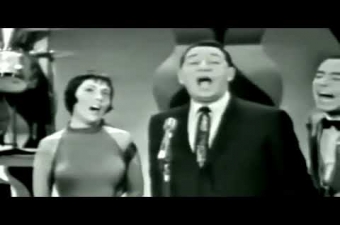Sho Bar
228 Bourbon StreetNew Orleans LA 70116
The Sho Bar opened in 1948, presenting burlesque acts such as Kitty West, who, as Evangeline the Oyster Girl, emerged from a giant oyster shell to jazz accompaniment and danced with a pearl the size of a volleyball. Blaze Starr, the “Queen of Burlesque,” performed here during her famous affair with Louisiana Governor Earl K. Long (Starr also claimed a dalliance with President Kennedy).
The Sho Bar’s musical history is just as rich. In late 1953, bandleader Louis Prima took a residency here with singer Keely Smith, whom he’d recently married (she was 25; he was 43 and had three ex-wives). Prima, who’d been discovered on Bourbon Street twenty years earlier, was developing material for Smith in an effort to update his act. In 1954 they got a gig in Las Vegas where, with saxophonist and Bourbon Street veteran Sam Butera, they rose to national fame and helped define casino entertainment.
As bebop turned on New Orleans musicians in the 50s, artists such as Harold Battiste and Melvin Lastie used after-hours jam sessions at Sho Bar to stretch out musically. Author Charles Suhor noted that strip clubs became unlikely redoubts for modernists, where “heavily accented phrases and ‘weird’ harmonies became part of the decidedly countercultural, borderline verboten ambience.” Exotic dancers at the Sho Bar performed to the sounds of a modern jazz house band including the great Smokey Johnson on drums.
In the early 60s some of the city’s top R&B acts performed here, including Ernie K-Doe (“Mother in Law”), Danny White (“Kiss Tomorrow Goodbye”), and King Floyd (“Groove Me”). Their late-night sets didn’t end until the sun was up on Sunday mornings. The singer Joe August, known as Mr. Google Eyes or Mr. G, often hosted these shows—he’d become a Bourbon Street mainstay after cutting records as a youngster in the 1940s and 50s.
Sadly, Mr. G left the strip after a harrowing experience recorded by author Jeff Hannusch in I Hear You Knockin’. He dated a white dancer from the Sho Bar, and they were arrested for “miscegenation” — simply being an interracial couple in public. When they got home from the police station the dancer told him “If I can’t have you nobody can,” and shot him in the stomach. He survived despite abuse from the white men driving the ambulance tasked with bringing him to the hospital.
The Sho Bar lived on (in another location on Bourbon Street) as a low-budget strip club into the 2010s. Its days as a live music venue were long over but it reportedly still engaged in B-drinking, a hustle dating back to the street’s early days as a vice district. It would start with a woman employed by the club asking a male customer to buy her drinks. The bar would sell real drinks for the men and overpriced, watered-down ones for the women, who kept a cut of the profits.
About Bourbon Street
Bourbon Street, one of the most famous streets in the country, is only 14 blocks long, running through the middle of the French Quarter. It took off as an entertainment district in the 1940s, when wartime activity brought waves of visitors to New Orleans. Bands often performed in floor shows featuring burlesque dancers (who stripped to varying degrees), comedians, and other entertainers.
This freewheeling era came to a close, in the eyes of many patrons, with District Attorney Jim Garrison’s vice raids in the early 1960s. Crime — organized and not — was pervasive on Bourbon Street, and Garrison’s crusade scored some political points. The resulting loss of revenue at the clubs, meanwhile, scaled back entertainment budgets.
The only black people on Bourbon Street at the time were there to work (musicians were generally considered hired help; some had to wait in storerooms between sets). Even after the passage of civil rights legislation some clubs resisted integration, and audiences on Bourbon Street remained largely white for years afterward.
In recent decades, as the city relied increasingly on tourism to prop up its economy, the market dictated more changes: Modern stripping supplanted burlesque and DJ booths replaced bandstands. The street became a pedestrian mall, filled with go-cups and Mardi Gras beads year-round. Several clubs sticking with live music offered low wages for bands to play songs familiar to visitors.
Hand-wringing about the quality and nature of live music on the strip has been more or less constant since the 1950s, and not without reason. Still, some venues persisted in hiring reputable artists. In the 2000s, the To Be Continued Brass Band took matters into their own hands, breaking into the scene by playing on the corner of Bourbon and Canal Street every night.
In any case millions of visitors to the strip each year find the spectacle they’re looking for, exotic but approachable, with a more permissive atmosphere than they feel at home. Its economic impact on the city is in the billions. If it’s crass it’s also egalitarian: Bourbon Street today is among the more integrated spaces in town.
By Jordan Hirsch
Videos

From 1959, after making it big in Las Vegas, Louis Prima with Keely Smith and Sam Butera perform "Just A Gigolo - I Ain't Got Nobody."
Video from Attila F..
From 1959, after making it big in Las Vegas, Louis Prima with Keely Smith and Sam Butera perform "Just A Gigolo - I Ain't Got Nobody."

In 1966, Rev. Bob Harrington, the "Chaplain of Bourbon Street," preached from the Sho Bar stage.
Video from Ingo Breuer.
In 1966, Rev. Bob Harrington, the "Chaplain of Bourbon Street," preached from the Sho Bar stage.

From the 2017 Ponderosa Stomp Music History Conference, Meters bassist George Porter, Jr. and drummer "Wacko" Wade Wright talk about playing on Bourbon Street in the 1960s.
Video posted by The Ponderosa Stomp Foundation.
From the 2017 Ponderosa Stomp Music History Conference, Meters bassist George Porter, Jr. and drummer "Wacko" Wade Wright talk about playing on Bourbon Street in the 1960s.
Images























